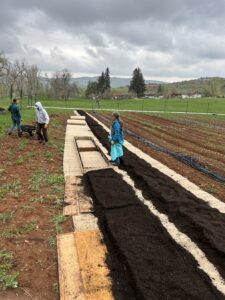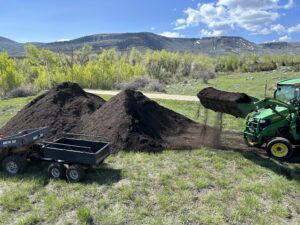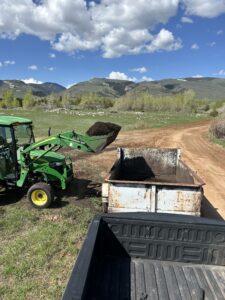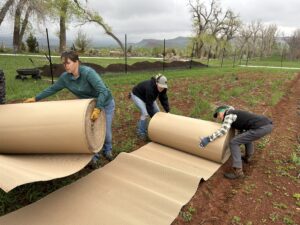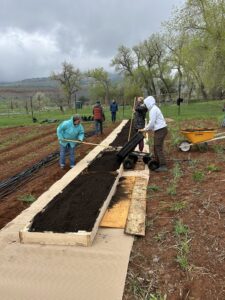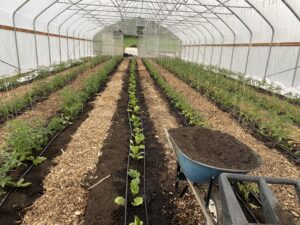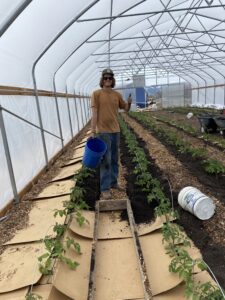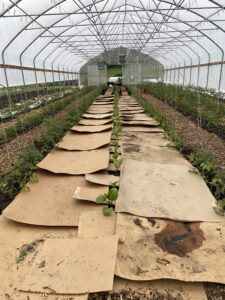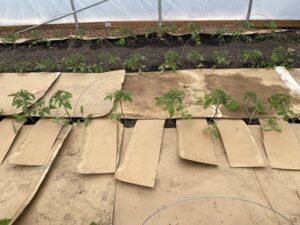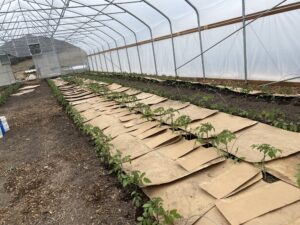Progress report for WRGR23-007
Project Information
The cardboard layering and deep compost mulch (CLDCM) system is an innovative method of weed suppression that positively impacts both the environment and farmers quality of life. This innovative method has been used successfully by home gardeners and smaller commercial growers for years, and involves placing cardboard on top of the soil, then adding 6-to-8 inches of compost, which effectively starves weeds and weed seeds of sunlight to the point that they cannot persist. With this SARE Research to Grassroots grant funding, the Central Wyoming College (CWC) Alpine Science Institute Farm in Lander, Wyoming and Sweet Hollow Farm in Victor, Idaho will replicate results of the research Richard Baruc (SARE funded project, FNE10-677): Soil and Plant Properties in Cardboard Mulch Prepared No-Till beds in the InterMountain West’s semi-arid high-altitude climate. The partnership will also build upon Sweet Hollow’s SARE funded Farmer-Rancher research project (FW22-393 : Cardboard Layering Deep Compost Mulch for Weed Suppression, Soil Health, and Profitability) by teaching other farmers and educators how to effectively implement the CLDCM method. This research-based method will be taught through a series of skill-building workshops in conjunction with other partner organizations throughout Wyoming and Idaho.
- For each project year, install CLDCM on 16 20’ x 100’ vegetable blocks (32 project total).
- Ten on Sweet Hollow Farm.
- Six blocks on the CWC Alpine Science Institute Farm (four in the education garden, site of the Crop Production Practicum for the Beginning Farmer Training Program, and assist two Incubator Farmers to install one each).
- Specialty crop producers will learn the technical skills required to install and manage CLDCM, and increase their knowledge of no-till soil practices.
- CWC will annually train 55 beginning farmers, Incubator Farmers and local market gardeners in the technique (110 project total).
- Sweet Hollow will annually train 25 workshare employees and general public through University of Idaho Extension (50 project total).
- Track results of CLDCM implementation to assess impacts in terms of labor savings, crop yield, and soil health, which foster environmental and financial sustainability of farm businesses. Share with specialty crop producers to increase their knowledge of the efficiencies and benefits provided by CLDCM.
Farmers attempting to reduce the use of toxic chemicals, improve nutrient density of produce, and build healthy soil can encounter tremendous pressure from weeds. Weed management is a large labor sink, yet efficiently managing weed pressure is extremely important to the viability of small farms (Stephenson, 2019) Labor on small-scale fruit and vegetable farms is a limiting factor to success and profitability and can account for up to 72% of farm expenses (USDA ERS, 2018, Stephenson, 2019).
Innovative practices such as the cardboard layering and deep compost mulch (CLDCM) system have the potential to improve soil health and plant yields, avoid environmental toxins, and combat weed pressure. Without the need for heavy machinery and tillage, farmers can grow more efficiently and profitably. This also increases the business viability for beginning farmers.
This project will synthesize CLDCM research and teach area farmers how to implement it on their own operations. CWC is an ideal partner as they operate a farmer-incubator program reaching the target demographic. They have a documented need for more effective ways to combat weed pressure through the initiation of their educational farm operation which was plowed from a well-established smooth brome pasture. Controlling brome and other aggressive weeds such as thistle is imperative to beginning farmer success.
This project is based on research from the Northeast SARE project, FNE10-677 Soil and Plant Properties in Cardboard Mulch Prepared No-Till Beds, and a Western SARE project, FW19-348 Sheet Mulch Using Cardboard and NFTs. Neither were located in the semi-arid climate of the Rocky Mountain West, but their outcomes are applicable to the soils, weed pressure, and farm techniques. This project will also include research from Sweet Hollow Farm Western SARE Project (FW22-393) as it is running concurrently and has shown significant potential for further application for CLDCM.
The activity timeline for the CLDCM project will follow the below outline for each project year:
- May 2023/24: Sloven will visit the CWC Farm to teach CWC faculty, staff, and beginning farmers how to assemble the CLDCM system. During his visit, a technical workshop will also be hosted for the general public.
- June 2023/24: CWC beginning farmers will visit Sweet Hollow Farm to compare the CLDCM blocks at each location, and view them in the context of a commercial operation.
- September 2023/24: Sloven will visit the CWC Farm to help record results of the CLDCM and host a field day for the general public with UW Extension Specialist Caitlin Youngquist.
Additionally, at Sweet Hollow, there will be a 3-part series with Mountain Roots Education.
Workshop 1 - Keep the Soil covered as Much as Possible (Spring 2023): Participants will build a test bed. Soil health principles will be discussed. The goal is to encourage participants to implement these strategies in their own farms and gardens.
Workshop 2 - Disturb the Soil as Little as Possible (Summer 2023): Participants will plant new no-till beds using the dibble method. Discussion around what is a living soil and how the nutrient cycle works in tandem with photosynthesis. Participants will leave with a better understanding of how plants feed the soil and vice versa.
Workshop 3 - Keep the Soil Planted as Much as Possible (Summer/Fall 2023): Discussions will be held on the importance of continuous plantings and the negative effects associated with beds lying fallow for extended periods of time. The developed CLDCM test bed will be compared with a control bed. Participants will look at soil microbes under a microscope to try to identify beneficial microbes, specifically nematodes. Participants will leave with practice identifying microorganisms and hands-on experience establishing no-till gardens.
Cooperators
- - Producer (Educator)
- (Educator)
Education & Outreach Initiatives
For each project year, install CLDCM on 16 20’ x 100’ vegetable blocks (32 project total). Ten on Sweet Hollow Farm, and six blocks on the CWC Alpine Science Institute Farm (four in the education garden, site of the Crop Production Practicum for the Beginning Farmer Training Program, and assist two Incubator Farmers to install one each).
On May 18-19, 2023 Jonah Sloven traveled to the CWC ASI Student Farm to deliver a workshop on soil health and how to install a new CLDCM system from scratch. On Day 1, Jonah presented on the benefits and limitations of no-till farming, as well as what the CLDCM system is and how it can benefit farmers. He spoke about his own experience using the technique and how it has helped his production efficiency over the past 3 years.
After the presentation, we began to install the CLDCM system on the ASI Student Farm using the methods Jonah described. There were 9 participants in total, and over the course of the 2 days we installed 5 (30"x100') beds. The process was initially quite slow as we worked out the methods and best ways to form our beds using s string line and bed forming "jig" to ensure we had beds that were straight and had the right amount of compost on top of the cardboard. Once beds were finished, they were planted with zucchini/yellow squash, tomatoes (2 beds), melons, and cucumbers.
Challenges: sourcing compost for CWC was the biggest challenge due to our rural location and lack of commercial providers. Luckily, project cooperator Caitlin Youngquist-Price had a connection in Billings, MT who was willing to deliver ~65 cu. yards of compost. We then had to dump it about 1/4 mile away since the truck was too heavy to cross the bridge to the farm. Then we had to move loads with our small dump trailer to the farm, and finally in wheelbarrows into our jig for forming the beds. Sourcing woodchips was also a challenge as local tree companies were too busy to get to our location to dump chips. This meant we waited several months for a load, and in the meantime the exposed cardboard began to break down. Our miscalculation in cardboard quantity also meant we had to use thinner material as the budget allowed, which is less durable.
On June 21-22 the beginning farmer class (6 participants) traveled to Teton Valley, ID to visit Sweet Hollow Farms and see how Jonah has used the CLDCM system over the past few years. We were given an in-depth tour and were able to see how his methods have evolved over time to be more efficient with installation.
Finally on Sept 21-22 Jonah returned to talk to the class about the end of the season and how to manage CLDCM beds accordingly. We discussed benefits and challenges that were experienced through the season.
In spring of 2023, 2 new CLDCM blocks were built at Sweet Hollow Farm in their newly constructed high tunnel. For this preparation Jonah determined it would be better to use thicker sheets of cardboard and mulch around the crops, than dibbling holes through the cardboard. Factors that were taken into consideration were existing weed pressure, crop spacing, and limited space in the high tunnel. In turn, Beds were planted with tomatoes, and then build using a jig to separate beds/pathways, and cardboard and wood-chips were brought in by the 5 gallon bucket. In beds, 4-6" of compost was spread over the cardboard and around the tomato plants. In the pathways, 6" of wood-chips were laid over cardboard. Beds were 30" wide and pathways are 18" wide. Moving material by hand obviously took more time and energy to complete but it was necessary in the greenhouse and allowed us to gain valuable time during our short season.
Throughout the rest of the season 5 more CLDCM blocks were constructed at Sweet Hollow. Because these beds were in the field, more space allowed the traditional CLDCM system to be used. We also utilizing a tractor loader which was much quicker. We determined these beds were to be left fallow the first season to better deal with existing weed pressure over dibbling holes through the cardboard right away, and to continue to let the compost age.
Challenges: As mentioned above, a notable challenge for us is sourcing quality compost. Compost can come in many different forms. The only product really available in our area is very woody and not balanced. From previous use, we understood that this can create problems in the first year or two with planting directly into the compost. We have also began to dive deeper into natural farming methods to increase nutrient cycling and enhance soil networks.
On May 10-11, 2024, Jonah Sloven traveled to the CWC ASI Student Farm to deliver a workshop on soil health and how to install a new CLDCM system from scratch. On Day 1, Jonah presented on the benefits and limitations of no-till farming to the crop practicum students, as well as what the CLDCM system is and how it can benefit farmers. He spoke about his own experience using the technique and how it has helped his production efficiency over the past 4 years. He then repeated that same workshop the following day for the public, where we had 10 participants. Ethan had to make an emergency trip away that same week, so Jonah ran everything.
Students and the public installed the CLDCM system on the ASI Student Farm using the methods Jonah described. There were 5 participants with the crop practicum, and 10 with the public workshop, and over the course of the 2 days 4 (30"x100') beds were installed. Like last year, the process was slow due to the use of mostly hand labor for filling our bed jig and moving compost. We installed fewer beds this year due to labor constraints. The process also backed up into spring planting, so the final bed wasn't finished until early June. Two of the finished beds were planted with zucchini/yellow squash and tomatillos. Since we experienced relatively poor growth for most crops in our previous year 1 cardboard beds, two beds were left empty for 2024 to allow the cardboard to begin to break down. We also were able to source better cardboard for 2024, using thicker slip sheets instead of thinner rolled cardboard. This made bed prep a little more difficult, since individual sheets had to be placed and weighed down, but their thicker construction meant more durability.
Challenges: sourcing compost for CWC continued to be a big challenge, but it was smoother in 2024. We used the same contact in Billings, MT to deliver ~65 cu. yards of compost. We still had to dump it about 1/4 mile away since the truck was too heavy to cross the bridge to the farm. Then we had to move loads with our small dump trailer to the farm, and finally in wheelbarrows into our jig for forming the beds. Sourcing woodchips continued to be challenging as well. We hope to find a better source in 2025, or at least someone willing to deliver multiple loads. We also experienced plant growth challenges, specifically with our beds from 2023. Expectations were high that the cardboard and compost would have broken down well, and we'd see increased yields. Unfortunately, this was not the case, as we experienced some of the same growth and yield issues. It's hard to pinpoint exactly why this was, but it could still be the cardboard breaking down and the soil biology still developing.
On July 24-25, 2024, crop practicum students traveled to Teton Valley, ID to tour Jonah's farm and see the results of his work over the past 5 years. Students enjoyed tying everything together, from our new beds at the ASI Farm, to his older beds that were now producing well. Students were also able to see some of his other SARE funded research projects, which was a good way to tie in SARE funding and on-farm results.
in 2024, Jonah did not make a fall trip to CWC, due to prior committments and other activies happening during that time of year. We hope to use our funding extension to bring Jonah back to the ASI Farm in spring 2025, as well as bring the class to Teton Valley again.
Short term outcomes/impacts- increased participant knowledge in areas of no-till farming, benefits of CLDCM system, and how to efficiently install it. Increased usage of CLDCM technique at participant home gardens.
Medium term outcomes/impacts- increased adoption of CLDCM system on participant small farms next season. 1-2 participants are looking to use the technique as they expand their home gardens.
Long term outcomes/impacts- increased use of CLDCM system on small farms.
Specialty crop producers will learn the technical skills required to install and manage CLDCM, and increase their knowledge of no-till soil practices.
CWC will annually train 55 beginning farmers, Incubator Farmers and local market gardeners in the technique (110 project total).
Sweet Hollow will annually train 25 workshare employees and general public through University of Idaho Extension (50 project total).
The trips by Jonah to CWC served to train participants in how to install and manage CLDCM beds, and the benefits of no-till practices. The CWC workshop in May included student and staff participants only, as our challenges with procuring materials meant everything came together at the last minute. We are planning a public workshop in the spring of 2024 to showcase the beds installed in 2023, as well as cover no till practices/how to install CLDCM beds. The CWC workshop in Sept also included student and staff participants, as we decided that the best way to reach the public would be when we install new CLDCM beds in the spring. However, CWC hosted a farm-to-table dinner in early Sept, with 86 attendees. Each had the opportunity to tour the farm and information was presented about the CLDCM project and how SARE has supported it.
During the 2023 season Sweet Hollow continued to educate producers and local shareholders in the benefits to using no till methods such as CLDCM. During various field days, 22 different producers participated in building beds and helping with the project.
In addition, Sweet Hollow hosted the 8 members from Teton County Conservation District board and toured the greenhouse while giving an explanation of the CLDCM project.
Sweet Hollow plans to host the 3 day workshop series outlined in the proposal in 2024.
In 2024, the spring workshop at the ASI Student Farm included approximately 15 students/staff and members of the public. It was structured over 2 days, repeating the same content each day but with a different audience. Several other public tours were conducted, including school groups, and local and regional organizations. These reached another 75-100 participants.
Short term outcomes/impacts- increased participant knowledge of CLDCM/no till practices. Increased usage of CLDCM technique at participant home gardens. Increased knowledge sharing among participants and general public.
Medium term outcomes/impacts- increased participant/public usage of CLDCM system next season.
Long term outcomes/impacts- increased usage on regional small farms as knowledge disseminates through networks.
Track results of CLDCM implementation to assess impacts in terms of labor savings, crop yield, and soil health, which foster environmental and financial sustainability of farm businesses. Share with specialty crop producers to increase their knowledge of the efficiencies and benefits provided by CLDCM.
At CWC the new CLDCM beds yielded less overall, depending on the crop, but required far less labor to manage weeds (approx. 8 hrs total weeding time through the season).
| Crop | Yield compared to non-CLDCM beds |
| Zucchini/yellow squash- dunja, goldfinch | n/a |
| Tomatoes- mountain merit, amish paste | approx. 1/4 the yield |
| Tomato- striped german | approx. 1/4 the yield |
| Cucumber- striped armenian, diva | approx. 1/10 the yield |
| Canteloupe- | n/a |
Yields were generally far lower than similar crops grown in non-CLDCM beds, with the exception being zucchini/yellow squash, which produced above average yields and was not planted in non-CLDCM beds either. Melons were also planted for the first time this season, so we have no yield data to compare with. Lower yields are typical of this system in the first season, as per Jonah's experience, so we expect to see an increase next year. It will be interesting to see how second season beds compare to newly installed beds in terms of yield and weed management.
The labor savings in weed management over the season was significant, but was partially offset by the high labor needs of installation. Efforts are underway to plan better for installation next season and have more tractor work done to fill beds and move compost. By hosting a public workshop we also hope to have more labor available to install the beds.
Results for CLDCM beds compared to traditional plantings show significant labor savings and increased yield potential. On average less than half the time was required for weeding/upkeep on CLDCM beds. For the new beds created in 2023, we do not have side-by-side harvest yield data as tomatoes were only planted in CLDCM beds. However results from our 2023 Farmer/Rancher project is as follows where control are traditional tillage preparations and test are CLDCM beds.
| Patterson Yellow (lbs) | Bridger Yellow (lbs) | Cabernet Red (lbs) | Conservor Shallot (lbs) | |
| Control | 366.4 | 372 | 448.6 | 422 |
| Test | 659 | 734 | 559.4 | 434.6 |
Percent increase 80% 97% 25 3%
At CWC in 2024, beds from 2023 continued to yield less overall, and plants were notably smaller in size. Weeding labor was again low, but did increase as weed seeds have blown in and competition has been reduced. Beds installed in 2024 generally yielded well, having chosen crops (yellow squash, zucchini, and tomatillos) that did well in new cardboard beds in 2023. We hope to see increased yields and plant performance in 2025, as the original cardboard beds will have now had 2 years to breakdown.
Short term outcomes/impacts- dissemination of first year results to participants and other area producers.
Medium term outcomes/impacts- evaluation of second year beds vs. first year beds next season for labor savings and yield.
Long term outcomes/impacts- increased yield over the duration of the project in installed beds, with labor savings slowly decreasing as cardboard breaks down and weeds regrow.
Educational & Outreach Activities
Participation summary:
2024:
Tours: 1 tour to Sweet Hollow Farms, 1 tour with approximately 86 participants during farm-to-table dinner at CWC Student Farm, 1 tour with Lander Valley High School culinary students, and 1 tour with the Casper Garden Club.
Travel scholarships: 10 scholarships to cover the costs of traveling to Sweet Hollow Farm, including travel, meals, and lodging.
Workshop/field days: 2 hosted at CWC Student Farm to install and evaluate CLDCM blocks.
Other educational activities: approximately 5 informal visits with members of the public who were hiking on a nearby trail, saw the garden, and wanted to know more.
2025:
Tours: 1 tour to Sweet Hollow, 1 tour with Lights On afterschool program, 1 tour with WY Nature Conservancy staff, 1 tour with conservation district staff, 1 tour with Utah State TRUE Program
Travel scholarships: 5 scholarships to cover the costs of traveling to Sweet Hollow Farm, including travel, meals, and lodging.
Workshop/field days: 2 hosted at ASI Student Farm to install CLDCM blocks (1 with practicum students, 1 with public)
Learning Outcomes
Project Outcomes
2023: At the CWC farm we now have a solid base of 5 beds to being to evaluate the effectiveness of the CLDCM technique over time, as well as increasing knowledge of class participants in the areas of no-till agriculture, labor management, and soil health. We look forward to adding more beds this year to be able to compare both years of the project and continue to build soil and assess labor savings to be able to disseminate to the wider community.
At Sweet Hollow, added CLDCM blocks contributed to farm success and increased local knowledge (producers and ag professionals) in no-till and the technique itself. It is believed that further use and positive results may increase adoption of these methods among local producers in the future.
2024: We have built upon our inital installation, and have gained valuable experience in how to construct and manage CLDCM beds. Hosting a public workshop was helpful to disseminate information to the wider public, and we hope to continue to do this in 2025. Surveyed participants indicated their intention to share information with ~25 additional people.
At CWC, potential incubator farmers expressed interest in using the CLDCM technique in their own operations in coming seasons. They could see the potential labor savings and were eager to try it on their own. An added benefit was the reducing in cardboard waste that often ends up in landfill instead of recycling.
Further study is needed to determine if this way of farming has long term effectiveness. At what point does the cardboard break down, weeds proliferate, and you need to reinvest the time and money to lay more cardboard and compost? Does the up front cost offset labor savings over the years? Are initial yield reductions (and therefore sales) worth the labor savings?
